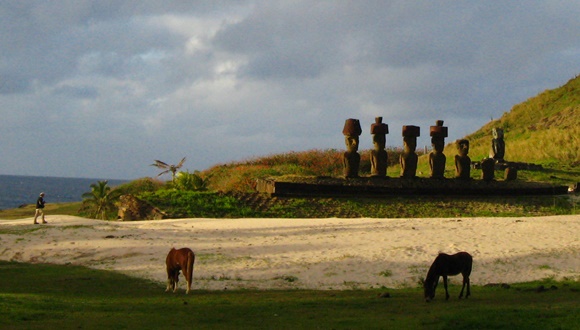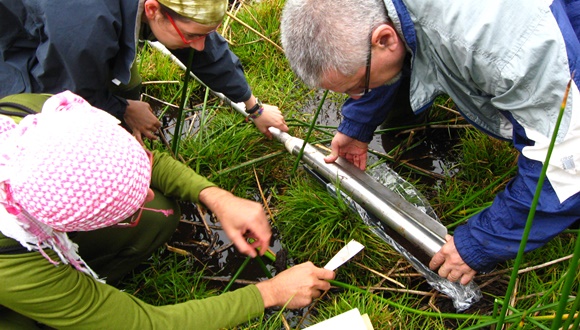Climate change and population growth: key factors in the decline of Easter Island’s civilization
The collapse of civilizations has always attracted our attention: entire books, films and thousands of legends have been dedicated to it. What makes some human populations disappear and others not? Is it related to climate crises and pandemics like the current ones?

The recent study Ecology of the collapse of Rapa Nui society involving CREAF researchers Olga Margalef and Sergi Pla-Rabés published in the journal Proceedings of the Royal Society B confirms that Easter Island’s aboriginal Rapa Nui society did not suddenly collapse, as was once thought. It actually underwent a gradual decline due to sharp population growth and climate changes to which the Rapa Nui were unable to adapt, preventing them from producing enough food. Analysis of climate data and archaeological remains, including charcoal from hearths and tooth collagen, has shaped the conclusions of a study that innovatively combines geology, ecology, population dynamics and archaeology.
The study, to which researchers from the Jaume Almera Institute of Earth Sciences (ICTJA – CSIC), the University of Barcelona and the University of Oslo also contributed, reinforces the idea that “civilization collapses often coincide with major climate fluctuations”, as Sergi Pla-Rabés puts it. “The capacity of the population of an island, a city or any other ecosystem to produce the resources it needs to survive has an upper limit”, he explains. “Rapa Nui population dynamics were conditioned by the society’s capacity to increase its production of resources (cultivated area) and by the climate. The first population decline observed took place in the first half of the 15th century, when the island had a dry climate (in the Little Ice Age), which affected productivity and consequently reduced per-capita food availability. Societies can anticipate their resource requirements from one year to the next and adjust production accordingly, but a sudden external alteration, such as a change in climate, can restrict the extent to which they are able to mitigate adverse effects.” The more recent falls in Rapa Nui population size owe much to the arrival of Europeans (18th century), who brought epidemic diseases and the slave trade to Easter Island.
Enlightening discoveries
Analyses performed on charcoal and carbonized matter from hearths, human teeth and other archaeological remains at the Catholic University of Chile have painted a precise picture of when Easter Island’s population shrank and indicated the dynamics models it followed in doing so. Thanks to radiocarbon dating, the researchers were able to estimate energy consumption based on when fires were lit and the age of remains. “We have proposed a Rapa Nui population dynamics model that combines paleoenvironmental and paleoclimatic data, a very relevant contribution”, says CREAF geologist Olga Margalef. “Easter Island’s landscape changes were caused by its inhabitants’ land management practices, although regional and climate events in the Pacific Basin could have magnified or modulated them”, she adds. “Furthermore, the population crises studied also entailed significant religious and social changes. It could be said that new cultures emerged after each major crisis, because the way the Rapa Nui had previously viewed the world ceased to be valid.”

Volcanic activity and tsunamis
In all likelihood, extreme phenomena such as volcano eruptions and tsunamis exacerbated the Rapa Nui society’s demographic crises. Along with the effects of climate changes, per-capita food availability and Easter Island’s carrying capacity, such extreme events were key factors in the society’s decline.
Based on its location, Easter Island probably suffered the consequences of great eruptions in the South Pacific in the 13th and 15th centuries, and would also have been exposed to tsunamis caused by earthquakes with epicentres on the coasts of Asia and the Americas. As the lead author of another study that looks at such matters, Olga Margalef explains that “the Rapa Nui were affected by extraordinary events, such as the 1960 Valdivia earthquake, generated in Chile, which caused a tsunami that reached Easter Island and moved the moai statues in its path a considerable distance inland. According to our calculations, tsunamis liable to affect Easter Island could have had a period of recurrence of under 100 years.” Such phenomena would have had a huge impact on the Rapa Nui, given that they initially lived in coastal areas and their economic activity revolved around fishing.
Referenced articles:
M. Lima; E. M. Gayo; C. Latorre; C. M. Santoro; S. A. Estay; N. Cañellas-Boltà; O. Margalef; S. Giralt; A. Sáez; S. Pla-Rabes; N. Chr. Stenseth 2020/06/20 Ecology of the collapse of Rapa Nui society https://doi.org/10.1098/rspb.2020.0662
Margalef, Olga; Álvarez-Gómez, José; Pla-Rabes, Sergi; Cañellas-Bolta, Nuria; Rull, Valentí; Saez, Alberto; Geyer, Adelina; Penuelas, Josep; Sardans, Jordi; Giralt, Santiago 2018/01/01 Revisiting the role of high-energy Pacific events in the environmental and cultural history of Easter Island (Rapa Nui) 10.1111/geoj.12253 Geographical Journal







